No CrossRef data available.
Article contents
Steels Used in Aero Work*
Published online by Cambridge University Press: 14 September 2016
Extract
Before proceeding, I wish to say that I much appreciate the invitation to present this paper to your Society. The science of aeronautics has evolved at a great pace, and typifies what can be done with applied science, and the tangible results are so apparent that it would be superfluous to discuss them. It would appear to me that the rapidity with which the efficiency has increased is due to the whole-hearted collaboration of the different branches of applied science and engineering, the honours being shared after giving first place 10 the sportinginstinct of the early flyer, by the physicist, the engineer, and the metallurgist. You will notice that my modesty places the metallurgist last. It is quite a confession to make, but it is a fact, nevertheless, that I accepted with pleasure your invitation to give this paper, principally because I have always taken a keen interest in the metallurgical side of aeronautics.
- Type
- Research Article
- Information
- Copyright
- Copyright © Royal Aeronautical Society 1924
Footnotes
Reprinted. Original report out of print.—Editor.
References
Note on page 471 * The factor of strength as fixed by the authorities is well known to be so many times theload borne by the supporting surfaces during straight horizontal flight.
Note on page 472 * Stanton & Bairstow, Proc. Insl. C.K., I.JO6, Vol. C1XVI.
Note on page 473 * Institution of Automobile Engineers, November, 1915.
Note on page 474 * Burls, p. 137, Aero Engines.
Note on page 476 * P. Breuil.
Note on page 477 * A. Martens, Materialienkunde fur den Maschinenbau
Note on page 480 * Unwin's Testing of Materials.
Note on page 497 * McWilliam and Barnes.
Note on page 500 * Noted by Professor Hopkinson in 1889.
† Invar and Related Nickel Steels.
Note on page 503 * Institution of Automobile Engineers, 1915.
Note on page 530 * See the I.A.K. Proceedings, 1915.


